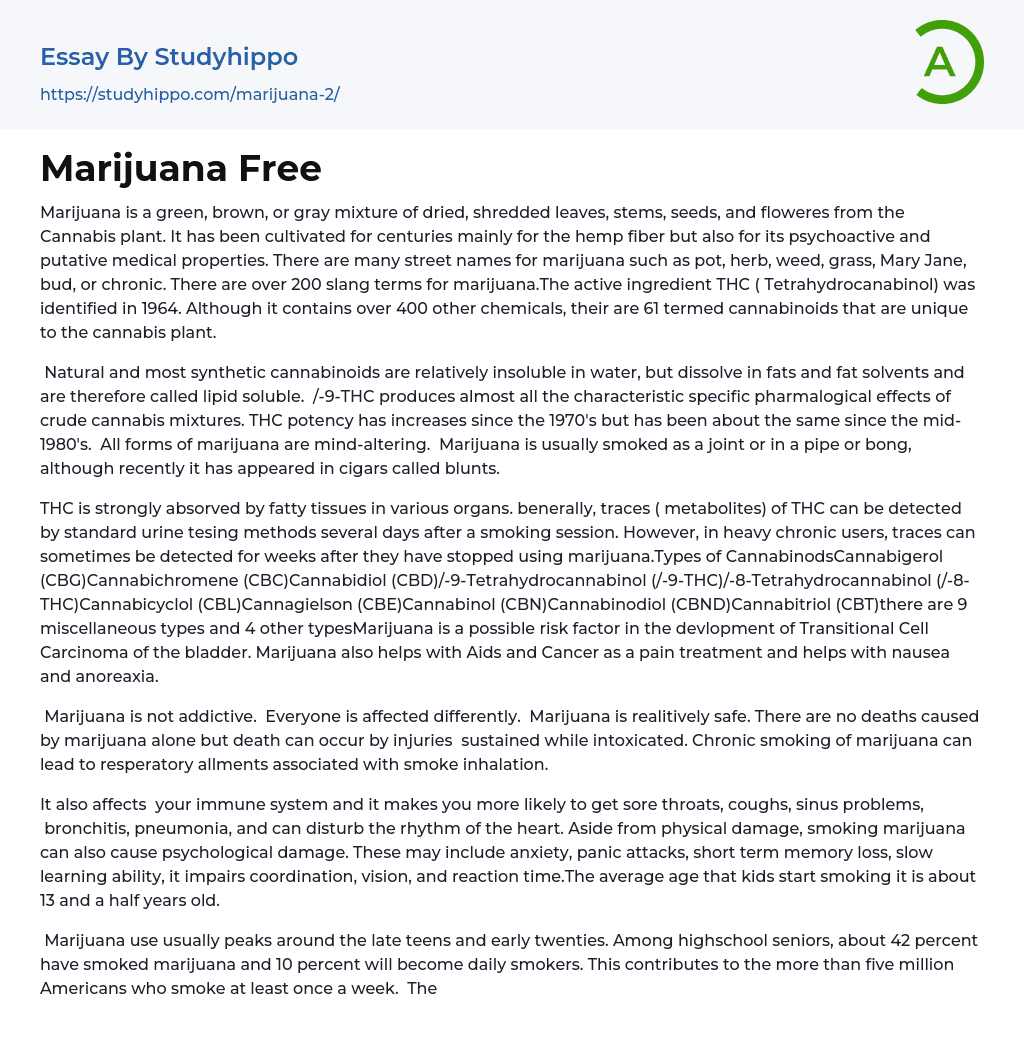The Cannabis plant, cultivated for centuries primarily for its hemp fiber, is responsible for producing marijuana. Marijuana consists of dried, shredded leaves, stems, seeds, and flowers. Besides its hemp fiber, the plant is also known for its psychoactive and potential medicinal properties. There are many street names used to refer to marijuana such as pot, herb, weed, grass, Mary Jane, bud, and chronic. In fact, there are over 200 slang terms associated with it.
In 1964,the active ingredient THC (Tetrahydrocanabinol) was identified in marijuana while it contains more than 400 other chemicals.The cannabis plant specifically has 61 cannabinoids.THC potency has increased since the 1970s but has remained relatively stable since the mid-1980s.Although these cannabinoids are typically insoluble in water they can dissolve in fats and fat solvents due to their lipid solubility.Most of the distinct characteristics found in raw cannabis mixtures are produced by t
...he pharmacological effects of THC.
Traces of THC metabolites can generally be detected several days after smoking through urine testing methods.However heavy chronic users may have detectable traces even weeks after ceasing use.Fatty tissues in various organs highly absorb THC.
All forms of marijuana possess mind-altering properties and can be smoked in a joint or pipe or consumed through a bong. However recently it has appeared in cigars called blunts as well.There are multiple types of cannabinoids, including Cannabigerol (CBG), Cannabichromene (CBC), Cannabidiol (CBD), -9-Tetrahydrocannabinol (-9-THC), -8-Tetrahydrocannabinol (-8-THC), Cannabicyclol (CBL), Cannagielson (CBE), Cannabinol (CBN), Cannabinodiol (CBND), and Cannabitriol (CBT). In addition, there are 9 miscellaneous types and 4 other types. Marijuana is considered a potential risk factor for the development of Transitional Cell Carcinoma of the bladder. However, it has been found beneficial in
treating pain and relieving nausea and anorexia in AIDS and cancer patients. It should be noted that marijuana is not considered addictive, and its effects can vary from person to person. While there have been no reported deaths caused by marijuana alone, fatalities may occur due to injuries sustained while under its influence.
Chronic smoking of marijuana can result in respiratory ailments associated with smoke inhalation. It can also negatively affect the immune system, making individuals more susceptible to throat problems, coughs, sinus issues, bronchitis, pneumonia, and disruptions in heart rhythm. Apart from physical harm, smoking marijuana can also lead to psychological damage such as anxiety, panic attacks, short-term memory loss reduced learning ability impaired coordination vision problems slowed reaction time. It should be noted that the average age for starting marijuana use is around 13 and a half years old.Usage of marijuana is highest among people in their late teens and early twenties, with approximately 42% of high school seniors having tried it. Out of those who have tried it, 10% become daily users. This contributes to the astonishing fact that over five million Americans smoke marijuana at least once a week. Throughout their high school years, most adolescents will come across marijuana. Reports indicate that children born to women who smoke marijuana experience difficulties with concentration. The primary reasons why kids start smoking include peer pressure, depression, problems coping, and boredom.
What's interesting is that compared to cigarette smoke, marijuana smoke contains 50% more cancer-causing substances. Surprisingly, smoking one joint causes as much damage to the lungs as smoking 20 cigarettes does.
The debate surrounding the legalization of marijuana has recently gained significant attention. Some argue
for complete legalization while others advocate for its medicinal use only. Jesse Ventura is one notable supporter of legalization because he believes it can generate tax revenue and reduce unnecessary arrests. This argument holds weight considering non-violent offenders contribute to prison overcrowding.
In just 1997 alone - the highest number in U.S.history - there were 695,201 arrests related to marijuana; interestingly enough, 87% of these arrests were for possession rather than dealing. Since 1965, over 11 million arrests have been made due to possession and usage of marijuanaThe number of individuals currently incarcerated for marijuana-related offenses is substantial, with approximately 15,668 in federal prisons, 13,670 in state prisons, and 7,222 in local prisons. This high number of incarcerations plays a pivotal role in the ongoing discussion surrounding the legalization of marijuana. The topic presents various advantages and disadvantages that consistently stir controversy regardless of the final decision.
- Cocaine essays
- Why Marijuana Should Be Legalized essays
- Drug Abuse essays
- Teenage Drug Abuse essays
- Tobacco Smoking essays
- Effects Of Smoking essays
- alternative medicine essays
- Aspirin essays
- Cannabis essays
- Cardiology essays
- Cloning essays
- Dentist essays
- drugs essays
- Hemoglobin essays
- Medical essays
- Medical Ethics essays
- Organ Donation essays
- Patient essays
- Pharmacology essays
- Plastic Surgery essays
- Surgery essays
- Therapy essays
- Vaccines essays
- alcoholism essays
- Casino essays
- Cell Phone Addiction essays
- Heroin essays
- Smoking essays
- Social Media Addiction essays
- Tobacco essays




